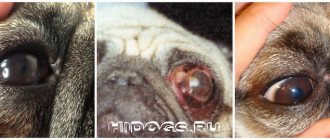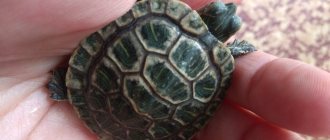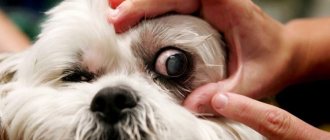Due to the structure of the skull and the shape of the eyelid, pugs often suffer from eye diseases. Tears, redness, and swelling are alarming and make you frantically look for ways to help your pet before visiting the veterinary clinic.
What eye diseases exist in dogs of this breed? What should you buy in your home medicine cabinet? When is it better not to delay visiting a doctor? Read our article!
Home care
You should start monitoring the condition of your pug's eyes 10 days after his birth. It is then that his eyes begin to open, and are visible from under the raised eyelid from the inner corner. The immunity of ten-day-old puppies is not yet strong enough, and if a nursing mother has conjunctivitis, it is likely to be passed on to the offspring.
Important! If your female pug has eye problems, treat them before treating her with a cable. This way you will prevent the possible development of diseases in future offspring.
You can keep your pug's eyes healthy by regularly following these rules:
- Check the corners of your eyes for dirt every day, especially after walking, and wipe them with a damp cloth.
- Monitor the state of lacrimation. If your eyes begin to water intensely or, conversely, become dry, this is a reason to consult a doctor.
- Make sure that while walking, litter, dust and sand do not get into the pug’s eyes.
- Make sure that the pug is not exposed to the wind or draft for a long time.
- Make sure your veterinary medicine cabinet is full so that you always have the necessary medications at hand.
What to wash and drip with?
If you are the owner of a pug, make sure that your veterinary medicine cabinet always contains the following medications:
- physical solution;
- chloramphenicol;
- tetracycline ointment;
- antiallergic drugs (tavegil, suprastin);
- tsiprovet.
Almost all of the above pharmaceuticals can be purchased at a regular “human” pharmacy. Having them at hand, you can be sure that, if necessary, you will be able to provide first aid to your pet and alleviate its condition before a medical examination.
How to wipe?
The pug's eyes are round and quite large. Due to their specific shape and the dog’s small stature, debris and dust regularly settle in them. You need to wipe your pug's eyes at the same time every day. This way you will accustom the dog to the necessary “ritual” of cleanliness, and he will not experience stress and resist.
Remove accumulated mucus with a cotton pad soaked in boiled water or saline solution, moving in the direction from the outer corner to the tear duct.
Important! Normally, a pug's eyes are slightly moist. Tears should not flow from them, nor should they be excessively dry and faded.
Drug treatment
It is believed that there are no ways to radically eliminate this disease. Overgrown pigmentation is difficult to respond to both conservative and surgical techniques.
In the treatment of pugs, both approaches are combined - a surgical scalpel and exposure to drugs. Local therapy is designed to stop the inflammatory process, often associated with pain. The four-legged patient is prescribed:
- cyclosporine;
- tacrolimus;
- corticosteroid drugs.
The first two drugs are equally effective, and the choice of one of them depends on the indications/contraindications of a particular dog. For pigmentary keratitis, the doctor usually prescribes corticosteroids, most often dexamethasone or prednisolone (in the form of direct injections into the conjunctiva of the eye).
But these medications have a significant disadvantage - they suppress the immune system, which begins to “miss” eye infections. Still, steroids are indispensable in the treatment of brachycephalic breeds prone to corneal ulcers.
Important! Occasionally, beta irradiation is used, which is justified in case of a large area of melanotic cataract and significant loss of vision. Removing pigmentation with a scalpel is considered ineffective, since after some time the spot appears again.
Eyelid surgery also helps to slow down the developing pigmentary keratitis, after which the inner corner of the lower eyelid is not able to cover the cornea. The doctor himself chooses the type of surgical intervention:
- Hotz-Celsus method;
- dissection of the medial canthal ligament;
- medial canthoplasty.
Pug owners pass on a recipe to each other, thanks to which the growth of pigment stops, and the thorn noticeably decreases in size.
First, the contents of the lidase ampoule are diluted with water for injection (5 ml). Next, dexamethasone (1 ml) and sea buckthorn oil (1 ml) are added to 1 ml of the resulting solution. Before instillation, done three times a day, the solution is shaken vigorously. Pugs tolerate the procedure calmly, as the liquid does not burn or sting.
After a course of instillation (about a month), take a week's break, since dexamethasone is a strong hormonal agent.
Before starting treatment, be sure to go to an ophthalmologist to clarify the diagnosis.
There is no remedy that can completely reverse pigmentary keratitis. Once the pigment coats the cornea, it becomes difficult to remove.
As a preventative measure and to reduce the amount of pigment, eye drops such as cyclosporine A (CSA) and tacrolimus should be used. Both of these drugs are immunomodulators, meaning they affect the immune system's response to what is happening in the eye.
How these medications may affect corneal pigmentation is still unknown. Taking the drugs can continue throughout your life.
If you stop taking it, it is likely that the pigmentation will intensify. An additional benefit of these medications is that they combat dry eyes (keratoconjunctivitis).
Some older dogs have dry eye syndrome, which worsens pigmentary keratitis. These drugs help with both diseases.
Keratitis in dogs is an inflammation of the cornea. It is often caused by injuries, although it is also a symptom of infectious hepatitis or canine distemper. This is the mildest form of superficial inflammation of the cornea, which affects the epithelium and sometimes Bowman's membrane.
Keratitis in dogs comes in many forms. It can be infectious, superficial purulent, phlyctenulous, deep (parenchymatous), punctate, catarrhal, vascular.
Treatment for conjunctivitis in dogs begins with removing pus and other discharge. To do this, dissolve a Furacilin tablet in a glass of warm water and rinse the pet’s eyes with the resulting solution. How to treat conjunctivitis in dogs and according to what scheme is described in detail in the table.
| Form | Treatment |
| 1. Catarrhal | The affected area is anesthetized with Novocaine (1-2 drops of a 0.25% solution is applied under the lower eyelid). Ointments are applied twice a day: Etazolic, Tetracycline, Sulfacyl sodium, etc. A good effect is achieved by using solutions of Kanamycin 1%, Levomycetin 0.25% (3 drops up to 5 times a day). Instead of drops, you can use medicinal films for the eyes (they include: Kanamycin, Neomycin and Sulfapyridazine sodium). They are placed under the lower eyelid, where they dissolve after a couple of hours and envelop the conjunctiva. The chronic form is treated with solutions of silver nitrate or zinc sulfate (a couple of drops up to 4 times a day). |
| 2. Purulent | The sore eye is washed with a solution of Boric acid 3%, drugs containing antibiotics (Ciprofloxacin, Ciprovet, Tobramycin, etc.) are dripped into the lower eyelid. In the morning and evening, ointments (Tetracycline, Etazolic, etc.) are applied to the mucous membrane. In addition to local treatment, a course of antibacterial drugs is added intramuscularly. |
| 3. Follicular | Conjunctivitis in dogs: treatment begins with relieving inflammation. In the follicular form, Albucid (4 drops in the morning, afternoon and evening), Dexamethasone (twice a day, 3 drops) are used for this purpose. Ointments are placed behind the lower eyelid: Tetracycline and Hydrocortisone. The drug Ribotan is injected into the femoral muscle (it accelerates the healing process of affected tissues). |
| 4. Allergic | First of all, exclude any contact of the pet with allergens that caused the development of conjunctivitis. The following medications are applied to the affected mucosa: Decta 2 (drops), Erythromycin ointment. Tablets are prescribed orally to relieve the pet of an allergic reaction: Suprastin, Claritin, etc. The affected eye is washed with Furacilin solution. |
| 5. Keratoconjunctivitis sicca | To treat this form, drugs containing cyclosporine (restores tear secretion) are used: Optimmune (ointment), Cyclolip (drops). They are applied to the mucous membrane up to 2 times a day for 3 weeks. Pathogenic microorganisms are destroyed using antibacterial drops: Ciprofloxacin, Tobramycin, etc. To eliminate corneal dryness, tear substitutes are used: Artificial tears, Natural tears, etc. |
READ MORE: Red eye syndrome treatment
Important! Conjunctivitis cannot be treated on your own without first consulting a veterinarian. Incorrect prescriptions can only aggravate the condition and lead to blindness.
Use of folk remedies
Folk remedies can be used as a complement to medication treatment. Conjunctivitis in dogs: treatment at home begins with removing accumulated discharge. They are removed using a clean cotton pad soaked in unsweetened, cool, weak tea or chamomile infusion.
Instead of tea and chamomile, you can use a very weak, slightly pink solution of potassium permanganate for rinsing.
Attention! If hard crusts have formed on your eyes, apply a little Vaseline oil to a cotton pad and carefully remove them.
The eyebright plant will help relieve inflammation. 150 ml of saline solution is poured into a clean container, five drops of extract are added to it, and then the affected eye is washed or a few drops of the resulting solution are instilled under the lower eyelid.
Until you can show your animal to a veterinarian, you can carry out the following procedures yourself:
- Rinse the dog's eyes with a cotton pad soaked in strong tea, chamomile decoction, furatsilin or a slightly pink solution of potassium permanganate. This must be done several times during the day. This procedure will help remove accumulated exudate in the corners of the eyes.
- Remove purulent crusts using Vaseline ointment.
- Make a compress from eyebright herb. Take 10 g of this herb, pour a glass of boiling water and leave for several hours. This decoction has good antibactericidal and anti-inflammatory effects.
In order to cure this pathology, it is necessary to urgently contact a veterinarian. He will conduct a thorough eye examination, take a culture of microflora from the diseased eye and prescribe the necessary treatment. Normally, the conjunctiva of the eyeball is pale pink in color, with a smooth surface and moderate moisture.
Also
It is important to promptly and accurately determine the reasons that could trigger the development of the disease. Conjunctivitis does not always manifest itself as an independent disease; sometimes such symptoms indicate metabolic disorders or the onset of infectious diseases.
Treatment of conjunctivitis in dogs is based on the use of ointments and drops containing antibiotics or glucocorticoid substances. They have anti-inflammatory and bactericidal effects.
In case of an allergic form, the doctor prescribes antihistamines.
Red squirrels
There may be three reasons why a pug’s eyes may be red:
Conjunctivitis
An inflammatory process caused by pathogenic bacteria or viruses entering the mucous membrane. With bacterial conjunctivitis, the eye becomes red and purulent discharge appears; with viral conjunctivitis, slight clear mucus appears.
Bacterial damage to the organs of vision should be treated with antibacterial drops and ointments. Perfect for this purpose:
- Tsiprolet;
- Phloxal;
- Levomycetin (drops);
- Tetracycline (ointment).
In case of a viral infection, it is enough to rinse the eyes with saline. solution until improvement occurs. If after 5 days of intensive treatment there is no improvement, be sure to visit a veterinarian.
Keratitis
With keratitis, redness of the eyes is accompanied by attacks of photophobia. The dog constantly closes its eyes in the light, and sometimes cannot open its eyelids at all.
Reference! In pugs, keratitis develops due to the growth of the nasal fold. Increasing in size, it begins to touch and damage the cornea of the eye.
In the early stages, the disease can be treated with medication under the supervision of a doctor. As it progresses, keratitis can lead to loss of vision or the vital need for surgical removal of the eye.
Entropy
Entropy is a disease caused by the appearance of an extra fold on the eyelid (most often the upper one). The eyelashes curl inward and put pressure on the eyeball. The disease can be detected only at six months of age and later. In particularly difficult cases, the problem is solved by surgical shortening of the eyelid.
Reasons for the development of the disease
Pigmentary keratitis, sometimes called color keratitis or corneal melanosis, is common in almost all brachycephalic breeds, but is most often diagnosed in pugs.
This serious ophthalmological disease can be triggered by several factors:
- injury or irritation of the cornea;
- inflammatory process that has become chronic;
- defects in eye development during extraembryonic (placental) formation;
- inversion of the medial corner of the eyelids (in brachycephalics);
- brachycephalic ocular syndrome;
- excessive folds on the muzzle;
- dry eye syndrome.
By the way, the last reason is to blame for keratitis in most dog breeds, with the exception of pugs.
The cornea is a convex-concave shell of the eyeball that refracts light rays. A healthy cornea free of pathologies is absolutely transparent. Keratitis of any etiology leads to a decrease in its shine and transparency. The inflamed epithelium of the cornea becomes cloudy or red, and microulcers appear on it.
With pigmentary keratitis, the clear epithelial cells are gradually filled with colored substances (biochromes), leading to darkening, clouding or blackening of the cornea.
Important! The determining factor for the development of pathology is (according to doctors) the breed of the dog: despite the similar structure of the head, pigmentary keratitis is much less common in bulldogs, shih tzus and Pekingese.
Catarrhal conjunctivitis in a dog photo
The conjunctiva is the mucous membrane on the inside of the eyelid. It protects the eyeball from injuries and foreign bodies, moisturizes the cornea. Inflammation of this membrane is called conjunctivitis. There are 5 types and corresponding symptoms of conjunctivitis in dogs:
- Catarrhal conjunctivitis occurs in two forms: acute and chronic (if treatment was not started in a timely manner). It is the result of a foreign body (a grain of sand, a twig, etc.) getting into the eye. The mucous membrane swells and turns red. Discharge (usually clear) flows from the corner of the eye. In many breeds of dogs, this type of conjunctivitis occurs in a chronic form (pugs, bulldogs, etc.).
- Purulent (bacterial, viral) conjunctivitis develops due to another disease (canine distemper, viral enteritis, etc.) or contact with the mucous membrane of the eye by bacteria and pathogenic microorganisms. The discharge is thick, purulent, with an unpleasant odor, white-yellow in color. The conjunctiva becomes inflamed and red.
- Follicular conjunctivitis in dogs usually occurs in a chronic form. Follicles located on the mucous membrane become inflamed and increase in size. This bothers the pet; discharge constantly flows from the eyes (without treatment they become purulent).
- Allergic conjunctivitis in dogs develops when the animal comes into contact with an allergen (certain medications, insect bites, household chemicals, etc.). The mucous membrane swells, tears flow profusely from the eyes, and follicles may enlarge.
- Keratoconjunctivitis sicca develops due to a lack of water in the tear (the mucous membrane and cornea dry out and become inflamed). There are many reasons for this phenomenon: injuries, congenital pathologies of the tear ducts, viral diseases, removal of the third eyelid, etc. Discharge from the eyes becomes viscous, sometimes mixed with pus.
With any type of conjunctivitis, the dog experiences discomfort and vision deteriorates. The purulent form without intervention can lead to complete blindness.
Important! If you notice that your pet has discharge from its eyes, contact your veterinarian.
Photos of conjunctivitis in dogs clearly reflect these signs.
Conjunctivitis begins to develop in dogs when pathogens (bacteria, viruses) enter the mucous membrane of the eye. If the animal’s immunity is weakened, the body cannot cope with this problem on its own. This leads to the development of an inflammatory process.
READ MORE: The upper eyelid is swollen - what to do? The answer is here!
In addition, the following factors can provoke this disease:
- Eye injuries.
- Hypothermia.
- Burns.
- Getting small particles of dust, fur or lint into your eyes.
- Allergic reaction to chemicals.
- The presence of concomitant infectious and inflammatory eye diseases.
- Vitamin A deficiency.
- Metabolic disease.
- Trichiasis is a disease in which the eyelashes on an animal's eyelid grow inward.
Dog breeds at particular risk include Dobermans, Pekingese, bulldogs, Yorkshire terriers, pugs, and Chihuahuas. This is due to the special structure of the eye in these animals. They have a slightly convex shape of the eyeball, which contributes to more frequent eye injury and foreign bodies getting into the conjunctiva.
Tears
Here are some reasons why your pug may be crying and blinking non-stop:
- Keratoconjunctivitis. Inflammation and increased lacrimation are caused by insufficient secretion of eye mucus and drying out of the apples. Treatment is selected by a veterinarian on an individual basis.
- Bringing debris into the eye - during a walk, sand or debris could get into the dog's eye, which causes irritation and tears. Carefully inspect your pet's eyes and if you find debris, thoroughly rinse the eye with physical water. solution.
Proper care
Since the Pug breed differs from other dogs in the anatomy of the facial bones of the skull and muzzle, the eyes will require daily care. In accordance with the breed standard, the pug's eyes are large and have a clearly defined round shape. This feature does not correspond to the breed standard, but is very common. The pug does not have a protruding nose to protect its eyes from various obstacles, so they are especially vulnerable to mechanical damage. Even a pug’s ears are better protected.
We recommend reading: You Can Give Vitamins to a Cat With Low Immunity and When You Shouldn’t
How to care for your pug's eyes? Examine your pet's eyes every morning, try not to skip this ritual; normally they are clear, without redness, spots or discharge. Due to the large size of a dog's eyeballs, a lot of dust and debris get into them during the day; they are eliminated naturally with the help of mucus. This mucus is harmless to the dog; it just needs to be removed every morning after sleep with a cotton pad soaked in warm boiled water. Instead of water, you can use chlorhexidine, keeping it out of your eyes.
Normally, a pug's eyes water moderately, this way the trapped debris is washed out. If the discharge is too heavy, you should consult a doctor.
Fester
Suppuration and sticky yellow-green crusts on the eyes are a sign of conjunctivitis that has developed as a result of a staphylococcal or streptococcal infection.
In the initial stages, you can get rid of the disease yourself by washing with saline solution and instilling antibiotic eye drops (Levomycetin or Floxal). In the absence of drops, you can use tetracycline ointment.
The procedure must be repeated three times a day. If there is no improvement on day 5, contact your veterinarian. He will select more effective treatment methods for your pet.
Symptoms of keratitis in dogs
You can also suspect the disease by paying attention to the behavior of your pet. Since conjunctivitis is accompanied by a feeling of discomfort and severe pain localized in the visual area, the dog becomes nervous, irritable, passive, often closes its eyes and rubs its eyes with its paws. Often with conjunctivitis, the animal experiences sleep disturbances and a permanent lack of appetite.
The pug has a rather expressive muzzle, which makes it quite easy to read your pet’s emotions. You immediately see when the dog is happy to see you, when he is sad or, unfortunately, something hurts. Understanding this fact itself is not difficult, but identifying the very cause of the dog’s poor condition is more difficult. Here you need to pay close attention to the symptoms that the animal has in order to determine the approximate cause of the pug dog’s illness.
The content of the article
Content
Conjunctivitis is quite common among dogs. This disease is characterized by an inflammatory process of the eye membrane. It would seem that everything is very simple - I put eye drops in the dog’s eyes and that’s it. But no. The disease is difficult to treat, which often leads to a complicated chronic form. Moreover, the disease is so dangerous that the animal can lose its sight.
- lack of appetite, general weakness;
- convulsions and paralysis;
- tremor;
- apathy towards everything.
Encephalitis can develop from a tick bite. In this case, the symptoms of the disease are as follows:
- body temperature rises sharply;
- convulsions and paralysis of the limbs begin;
- motor functions are impaired;
- the pet is very sensitive to everything;
- mood changes suddenly;
- eye, facial muscles - complete paralysis.
READ MORE: Gymnastics for hernias under the eyes
The statistics of encephalitis in pugs is growing, and there are no effective treatment methods. The disease causes irreversible destruction of brain cells.
Why did the spots appear?
If your pug has strange spots on its eyes, you should not hesitate to visit a doctor. The cause of the disease in most cases is pigmentous keratitis. Pugs are susceptible to this disease for a variety of reasons:
- turning of the eyelids;
- trichiasis;
- districhiasis;
- dry eye syndrome;
- lagophthalmos.
Pigmentous keratitis requires intensive treatment under medical supervision. If the disease is left to chance, the dog may go blind or lose an eyeball.
Cloudy film and eyesore
A cloudy eye, as if covered with a whitish film, in most cases is a consequence of injury. Only a veterinarian can accurately determine the cause and extent of the damage, as well as select the appropriate treatment. In most cases, treatment with antiviral, wound-healing or antibacterial drops is prescribed.
If the consequences of the injury are not treated in a timely manner, an incurable thorn will form on the eye, which will affect the pet’s visual acuity.
What to do if you are injured?
In pugs, like other brachycephalics, the eyes are injured very often. If you notice that the eye is red, watery and swollen, consult the contents of your veterinary medicine cabinet. Levomycetin or tetracycline ointment will help relieve signs of inflammation, and eye drops will reduce tearing on the damaged cornea.
Reference! In some cases, large debris may get into the eye, which, sinking into the folds of the eyelid or tear ducts, causes severe discomfort to the pet. It can only be obtained using a special medical instrument in the veterinarian’s office.
Two types of discharge
First you need to decide what kind of discharge your pet has. There are two types of discharge from the eyes:
Mucus discharge is not dangerous. These are, as a rule, oxidized tears of a reddish-yellow hue. They appear after sleep if lint, dust, fur, etc. get into the eye. They can also be a sign of eye inflammation and conjunctivitis. But this is not all that dangerous.
Purulent discharge, unlike mucous discharge, is greenish-yellow in color, and can be a sign of diseases such as:
But, in addition to all this, a pug’s eyes can also fester due to other serious diseases, such as distemper.
Bulging
Pugs have a rather specific skull structure due to which their eyes are essentially protected only by their eyelids. Severe stress, old age, weakened immunity can lead to eyeball loss.
It is quite difficult to confuse this phenomenon with something else. The pet looks scary - its eyeball looks huge and protrudes from its socket. It is covered with small vessels and is very watery.
The owner’s main task in this situation is to calm down and do everything possible to preserve the health of the animal. Act clearly and quickly, following the following instructions:
- Rinse the eye generously with saline. solution.
- Secure a sterile napkin on it with a bandage.
- Take your dog to a veterinarian immediately or call a doctor at home.
The specialist will set the eye back in place and tell you what care the animal will need in the future.
Eyes
The large and expressive eyes of pugs are the calling card of the breed and one of the main problems of the owners.
Cataracts and conjunctivitis
One of the pug's problems is cataracts, which is inflammation and clouding of the eyeball.
You can notice signs of the disease not only by examining the eyes, but also by the behavior of the pet, which, due to deteriorating vision, may begin to bump into objects.
If left untreated, cataracts can cause your dog to become blind . Treatment is carried out surgically. In case of inflammation of not only the eyes, but also the area around them, we can talk about conjunctivitis. This disease is dangerous because, due to infection, it can cause more dangerous inflammation.
In this case, you need to forget about walking for a while. You need to treat your pug's eyes with a cotton swab dipped in chamomile infusion and contact a veterinarian, who will prescribe special drops.
Eyeball prolapse
It happens that pug owners have to deal with such a problem as the dog’s eyeball falling out of the orbit.
This problem may occur due to a blow or insect bite. It is perhaps the most common ailment for pugs.
This is definitely an unpleasant and even terrifying sight. However, you must not lose your composure and take active actions - this can only harm the dog. You need to take a piece of clean, damp cloth, apply it to your pet's eye and immediately take your pug to a veterinarian, who will help restore the eye.
If for some reason it is not possible to go to a veterinary clinic, you need to act independently. It is necessary to wash and, preferably, disinfect your hands, take a bandage and press your hands on the eyeball. Then close the pug’s eyelid and apply a sterile bandage for several hours.
If nothing is done, the dog could face surgery and loss of the eye.
Cornea problems
Another common pug eye disease is keratitis , an inflammation of the cornea of the eye. Main symptoms of keratitis:
- Redness of the eye.
- Sores.
- Cloudiness in the eye.
The disease is the result of exposure to external factors or allergies. Such a phenomenon as pigmentary keratitis is characterized by the proliferation of eye pigment. The disease is treated with local medications or surgery.
Strabismus
Strabismus, or strabismus, can occur in dogs of all breeds and ages. As for pugs, strabismus often occurs due to birth trauma. Accordingly, if the pathology is congenital, there is no need to do anything about it, since the dog does not experience discomfort or visual disturbances.
But it also happens that the cause of strabismus is a skull injury or an infectious disease. In this case, the possibility and need for treatment is selected by the doctor individually - this could be chemotherapy, a course of antibiotics or surgery.











